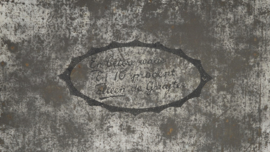A R C H I V E
Vintage tin "De Gruyter's Cacao Groenmerk"
SKU: 1571Vintage tin "De Gruyter's Cacao Groenmerk".
Green and brown colored tin box for DE GRUYTER'S COCOA.
- Maker: Dutch
- Manufacturing date: 1945/1985
Description
Vintage tin with a rectangular shape. Fitted with a hinged lid with needle hinge. Bottom and side seamed. The decoration of this tin consists of brown and green surfaces that are separated by golden lines. On the left side of the lid is an oval medallion, in which a woman's head and plant. Text: "The Gruyter's cocoa green brand."
This vintage tin is in a used condition with various traces of wear and tear.
Sizes
- Height: 8.6 cm.
- Length: 14.8 cm.
- Width: 9.8 cm.
De Gruyter was a retailer in the Netherlands in the 19th century and 20th century (until 1976). At its peak, there were more than 550 stores and nearly 7,500 employees.
Piet the Gruijter (1795-1867), started in 1818 in 's-Hertogenbosch with a horse fry mill, a listing for the processing of legumes, seeds, and grains. Later, his son Louis (1833-1911) took over the company. The clientele consisted mainly of farmers near 's-Hertogenbosch.
At the end of the 19th century, a chain of stores was added, initially in 's-Hertogenbosch. In 1896 a shop in Utrecht was opened and in 1902 one in Amsterdam.
The leadership of the company De Gruyter had also included a third generation: the children Lambert (1873-1951) and Jacques (1875-1950). In 1912 began the roasting of coffee.
An important element in sales policy was giving 10% discount on presentation of receipts. The slogan of De Gruyter became "And better value and ten percent, only De Gruyter". This loyalty was rewarded and they had an additional means to control the store managers. Because De Gruyter only sold own brand products prices did not compare to those of others.
In 1913 the 44th store opened in the Netherlands. Most stores were at that time located in the four major cities of the Netherlands.
In the compartmentalized Netherlands De Gruyter was the shop of Catholics, Protestants chose among others for Albert Heijn. With the depillarization, these ratios were gradually loosened after 1950.
In the sixties, De Gruyter group reached his peak. There were more than 550 stores and nearly 7,500 employees. In 's-Hertogenbosch had arisen large production sites. The group had food shops scattered throughout the country.
As a customer, binder De Gruyter started in 1948 to give away every week a small gift for children: the legendary Candy of the week. It was introduced after the Second World War when there was to supply of sugar. With the buy of a few guilders of groceries, free candy was given away for the children. Later, the "sweet" was a plastic toy, a game, a doll or a book every week something else.
Cocoa bean
The cocoa bean, also called cacao bean, and cacao, is the dried and fully fermented seed of Theobroma cacao, from which cocoa solids and, because of the seed's fat, cocoa butter can be extracted. The beans are the basis of chocolate, and of such Mesoamerican foods as mole and tejate.
Consumption
People around the world enjoy cocoa in many different forms, consuming more than 3 million tons of cocoa beans yearly. Every consumer has a unique taste and preferences of the end product. Once the cocoa beans have been harvested, fermented, dried and transported they are processed in several components. Processor grindings serve as the main metric for market analysis. Processing is the last phase in which consumption of the cocoa bean can be equitably compared to supply. After this step, all the different components are sold across industries to many manufacturers of different types of products.
Global market share for processing has remained stable, even as grindings increase to meet demand. One of the largest processing country by volume is the Netherlands, handling around 13% of global grindings. Europe and Russia as a whole handle about 38% of the processing market. Average year after year demand growth has been just over 3% since 2008. While Europe and North America are relatively stable markets, increasing household income in developing countries is the main reason of the stable demand growth. As demand is awaited to keep growing, supply growth may slow down due to changing weather conditions in the largest cocoa production areas.
Some translations come from an automated system and may contain errors.






















